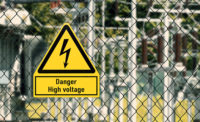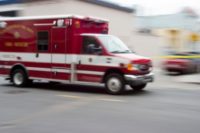Alarms, alerts and signage

For decades, companies have posted caution signs and set speed limits for forklift operators as a way to protect against catastrophic forklift-pedestrian accidents. Yet an important fact is that nearly 100 workers are killed each year in the U.S. as a result of forklift-related incidents, which is a strong indication that more is needed, especially at the loading dock where special circumstances elevate the safety risk. Here are three best practices that will help create a safer dock for pedestrians and forklift operators alike.
PRACTICE #1: Appreciate the job of the forklift driver
Loading docks are busy places where forklift operators are typically working the hardest, and at a fast pace. Loading and unloading trailers takes an extra level of concentration and sense of awareness. Challenges specific to forklift operators working in shipping/receiving/staging areas include:
Impaired vision: A forklift driver’s ability to watch for pedestrians is severely hampered when the forklift moves into the trailer where it is essentially operating inside a tunnel. A dangerous blind spot exists until the forklift has fully backed out of the trailer.
Unexpected dock entry: Pedestrians and visitors can often enter the loading dock area without forklift operators’ knowledge, such as from a side door.
Out-of-bounds pedestrians: People often step out of zones designated for pedestrian travel. This might include truck drivers who enter a facility to engage and disengage the vehicle restraint, technicians who service docks, employees who manually assemble pallet loads, and employees traveling from dock opening to dock opening.
Stopping requirements: A forklift moving at 10 mph may take 40 feet to stop. One study shows that a panic stop takes 1.3 feet for each mile per hour. Slippery or wet floors make it even more difficult to quickly stop a forklift’s momentum.
PRACTICE #2: Understand why pedestrians are at risk
Pedestrians face their own safety risks that are unique to the loading dock. They include:
Limited vision: People working on the dock have difficulty seeing forklifts when they are operating inside the trailer, especially when trailers are approached from the side and a forklift is handling pallets at the front end of the trailer.
Limited protection: The staging area in front of the dock door is there to allow unrestricted movement of forklifts, which makes it a dangerous place for pedestrians. Painted yellow lines on the floor offer little protection for keeping pedestrians out of the area.
Conditioning to forklift alarms: Forklift operators typically rely on the steering wheel horn to warn pedestrians. However, pedestrians can become accustomed to, and even may ignore, audible and flashing/ rotating/strobe lights on forklifts.
Difficulty hearing: Hearing protection can impede pedestrians’ ability to hear audible devices or sense where the sound is coming from.
PRACTICE #3: A comprehensive approach
There is no single, fail-safe solution to preventing forklift-pedestrian accidents at the loading dock. A comprehensive strategy that goes beyond signage, including radar-controlled signs, is the best approach. Methods and technologies to incorporate into a comprehensive effort include:
Mandatory forklift operator training: OSHA governs powered industrial truck safety under 29 CFR 1910.178. Under the standard, employers must certify that forklifts operators have been trained and evaluated before operating a forklift. Companies need to comply with the standard and take advantage of free or paid forklift safety training programs.
Separate forklift and pedestrian traffic: Painted yellow lines on floors often fade and provide limited visibility with little, if any, added benefit. A best practice is to install fabric safety barriers or fixed-guardrail units that separate and define areas of an interior loading dock - and protect pedestrians, machinery, equipment, workstations, and products from the dangers of forklifts. They also address the shortcomings of painted lines. A key consideration is to limit some aisles to pedestrian- or forklift-only traffic.
Equip forklifts with safety devices: OSHA requires forklift operators to sound the horn at cross aisles and other locations where vision is obstructed. In addition to a horn, there are a wide variety of other forkliftmounted devices worth careful consideration based on each individual application. One basic example is rearview mirrors.
Educate pedestrians: Pedestrians can fall into a false sense of security by thinking forklifts will always watch for them and sound their horn. The best practice is to ensure pedestrians fully realize the need to be alert for the vehicles, get out of the way when they hear a horn, and understand that blind spots may limit a forklift driver’s visibility.
Forklift-pedestrian technologies: These range from convex mirrors mounted on walls for improved visibility to proximity laser scanners used to create forklift-safe zones throughout the plant or warehouse. Other technologies include motion sensors or infrared systems to alert pedestrians that forklifts are at plant intersections, or when forklifts are approaching from somewhere in the plant.
Advanced dock communication systems: Consider technology that focuses specifically on forklifts and pedestrians at the dock. One such system uses highly visible lights and an alarm to communicate the status of forklifts inside the trailer. With the system, forklift drivers and pedestrians know when a forklift is working inside the trailer so they can exercise proper caution against that forklift backing out. The system can also enhance communication used to signal the status of vehicle restraints to the forklift operator, adding another level of protection against potentially catastrophic trailer-separation accidents.
The answer is clear
Posting signs that caution pedestrians about the presence of forklifts and/or putting radar-controlled signs in place to keep forklift operators from breaking the company-established speed limit can definitely help prevent forklift-pedestrian accidents. But safety managers must ask themselves whether extra measures, such as advanced systems that automatically warn pedestrians and other forklift operators that a forklift is inside the trailer, are worthwhile. More often than not, the answer is clear given the busy dock environment and the catastrophic outcome of most forklift-pedestrian collisions.
Looking for a reprint of this article?
From high-res PDFs to custom plaques, order your copy today!





